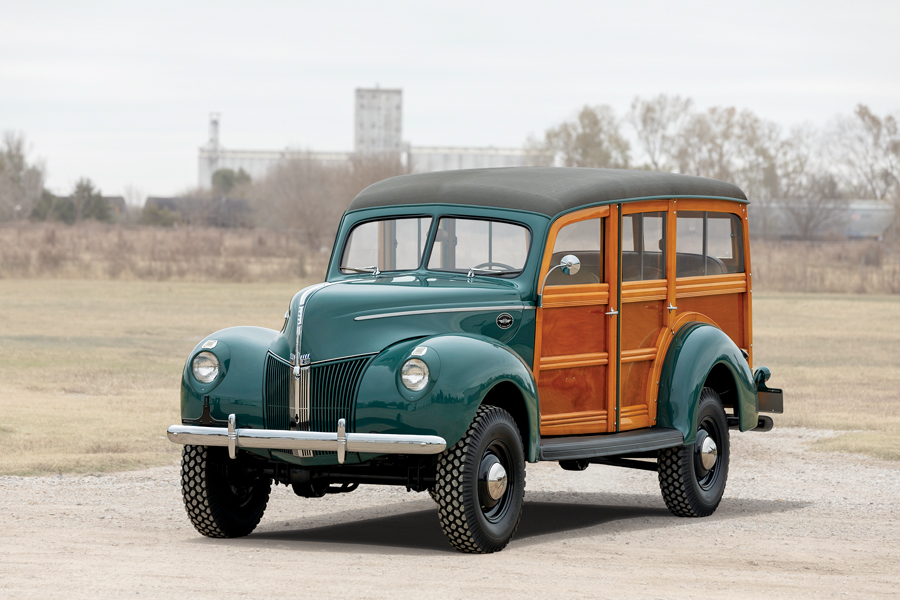- Formerly of the Nick Alexander Collection
- Rare Marmon-Herrington all-wheel-drive woodie
- Multiple award winner, including First in Class at Pebble Beach, 2003
SCM Analysis
Detailing
| Vehicle: | 1940 Ford Marmon-Herrington Standard Station Wagon |
| Years Produced: | 1937–40 |
| Number Produced: | 3,255 (standard station wagon; M-H conversions unknown) |
| Original List Price: | $947 ($1,800 for an M-H conversion) |
| SCM Valuation: | $239,250 |
| Tune Up Cost: | $100 |
| Chassis Number Location: | Top of left frame rail, near steering box |
| Engine Number Location: | Bellhousing |
| Club Info: | Early Ford V8 Club of America |
| Website: | http://www.earlyfordv8.org |
| Alternatives: | 1935–40 Chevrolet Suburban, 1941–42 Chrysler Town & Country, 1953–57 International Harvester Travelall |
| Investment Grade: | A |
This car, Lot 268, sold for $252,000, including buyer’s premium, at RM Sotheby’s Phoenix, AZ, auction on January 18, 2019.
There’s a reason the SUV was invented. People have always wanted or needed to go places where there aren’t any roads.
By the mid-1930s, automakers knew that four-wheel drive was a key feature in creating a capable go-anywhere vehicle, but it was expensive to implement. Further, most people back then weren’t willing to pay extra for such a feature unless they really needed it, so the market for 4WD was too small to warrant a regular production option.
That would all change after World War II and the development of the basic Civilian Jeep (CJ), but in the pre-war years you could still get 4WD if you were willing to pay the aftermarket price to get it. Companies such as Marmon-Herrington (founded in 1931) and NAPCO (from 1942) existed to take a standard vehicle and give it the off-road treatment.
Marmon was the same company that produced the 1911 “Wasp” racing car that won the very first Indianapolis 500. Marmon went on to produce luxury touring cars through the 1920s. When that market dried up in the doldrums of the Great Depression, Marmon partnered with Col. Arthur Herrington to change course and pursue military contracts for 4WD heavy trucks and tow vehicles.
By the mid-’30s, the company branched out and offered 4WD-modified civilian vehicles as well. Marmon-Herrington is still in business today, making 4WD conversions for heavy trucks such as Freightliner, Kenworth and Peterbilt, among others.
Expensive in its day
In 1940, a Marmon-Herrington-modified Ford wasn’t exactly cheap. Where a standard Ford station wagon cost about $947 in standard trim and $1,014 in Deluxe trim, the Marmon-Herrington started at $1,805, plus some extra depending on the wheels and tires you ordered. So it was easy to pay $2,000 for a Marmon-Herrington Ford back in 1940. That works out to about $35,500 in today’s dollars, or roughly the price of a basic three-row AWD crossover, which is what you were buying.
What you got for your money was a new Ford vehicle, either a truck or a passenger car, with an upgraded clutch and transmission, a single-range transfer case, and a modified rear axle with universal joints to drive and steer the front wheels. The car’s frame was also updated with additional bracing. Early conversions were full-time AWD, but starting in 1939, Marmon-Herrington vehicles were equipped with the ability to disconnect the front axle and run in RWD mode.
Trucks and wagons were popular conversions, but the M-H kit could theoretically be installed on just about any Ford. While Marmon-Herrington vehicles were expensive, having a big SUV was not a status symbol in that era. Consequently the modified trucks and wagons tended to be purchased by businesses for work purposes. Oilfields, mining operations and forestry were popular applications for Marmon-Herrington trucks.
A rare gem
Today, it’s comparatively hard to find a Marmon-Herrington vehicle, and truly rare to find one in show condition. There never were very many made, and these rigs had tough lives. It’s not surprising that only a few survived, and extant examples are now counted in the tens, not the hundreds.
The subject vehicle, a woodie wagon, resided in New England at least since the ’50s, and was purchased, restored, and placed in a collection back in 2000. This particular woodie won its class at Pebble Beach in 2003, and has collected other top awards as well.
It’s hard to establish a comparable price for a vehicle like this, but let’s start by noting that concours-winning Ford woodies of the era have been known to sell for well over $100,000 (ACC# 256715). Solid examples routinely trade in the mid to high five figures (ACC# 6878965) and sometimes peak over $100,000 (ACC# 245185). The most recent recorded sale of another Marmon-Herrington conversion in the ACC Premium Auction Database was a 1939 pickup truck that went for $66,000 in 2016 (ACC# 6805337).
Yet for all that, this sale is unique. This vehicle brings together the rarity of the Marmon-Herrington conversion on a passenger car with the quality of a Pebble-winning restoration.
It’s unlikely that you could ever find another car like this in anything like this condition, no matter how much you were willing to spend. With that in mind, $252,000 is a great buy on an unmatched and irreplaceable piece of Americana.
(Introductory description courtesy of RM Sotheby’s.)
